Last week when the librarians at my school met with our Lexis representatives, we asked when the recently purchased Ravel Law visualization technology would be incorporated into Lexis Advance. They didn’t make any promises on the time frame but said that the technology would first be incorporated into the Shepard’s results view. I was surprised because I hadn’t even thought of that, assuming LexisNexis would use the technology in the same way Ravel Law had – in the search results view. Quickly enthusiastic, I tried to imagine what it would look like.
Before pondering how the new view might look, let’s take a look at the current Ravel Law and Shepard’s graphical views.
Ravel Law View of Search Results
Below is a Ravel Law screen shot of the results of the search “concealed carry” in all federal and state cases. Instead of displaying a list of cases like other services, Ravel Law displays search results in a citation map which is organized by date on the X axis and by court on the Y axis. Each circle represents a single case and the lines between cases show how they are connected through citation. The more a case is cited, the larger the circle. This ingenious graphical view helps a user to quickly make sense of search results. In this example, you can see that “concealed carry” was mainly a state law issue until approximately 2008 when suddenly a number of federal cases culminated in an important (the big circle!) 2010 United States Supreme Court case, McDonald v. City of Chi., 561 U.S. 742, 130 S. Ct. 3020 (2010).
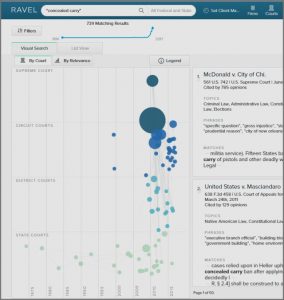
Ravel Law View of a Single Case
Ravel Law provides the same citation map view for a single case. This graphical view shows all the cases that cite McDonald and how those cases are connected to each other.
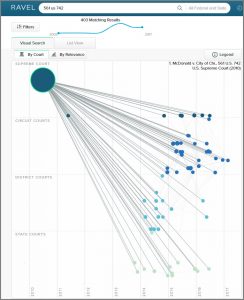
Shepard’s Results Graphical View – Appellate History
The current Shepard’s graphical view of appellate history is already very similar to the Ravel Law citation map, arranged by court on the Y axis and by date on the X axis.
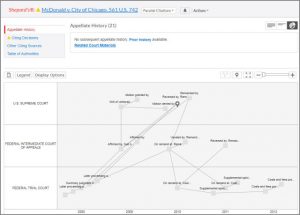
Shepard’s Results Graphical View – Citing References
The current graphical view of the citing references for a case provides a very quick and useful overview of analysis, court, and date.
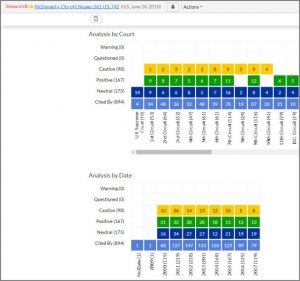
What Will It Look Like?!?
What will it look like when the Ravel Law visualization tools are incorporated into Shepard’s results?!? Well, I could be wrong, but it seems like the people at LexisNexis already know how to create a citation map with a court Y axis and a date X axis, as shown by the current Shepard’s appellate history graphical view. They didn’t need to purchase Ravel Law for that!
So that leaves incorporating a citation map into the citing references view. We already know what a Ravel Law citation map for a single case looks like, so we could start there and then add in the info from the citing references graphical view – analysis, jurisdiction, and date. We color the case circles analyses colors and create the option to filter by specific jurisdiction and specific analysis. Even though the date is on the X axis, there could still be an option to filter to a specific date range. (And, of course, there is no reason to exclude the additional filters that are available in the non-graphical view of Shepard’s results – publication status, depth of treatment, and headnotes.)
Voila!!
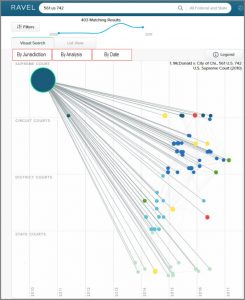
Editor’s Note – This article published with the permission of the author – first publication on RIPS Law Librarian Blog.
